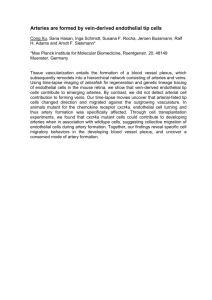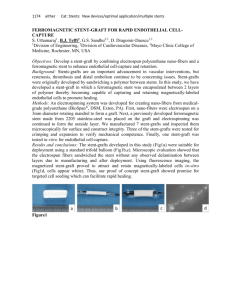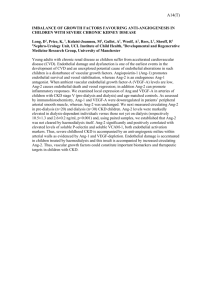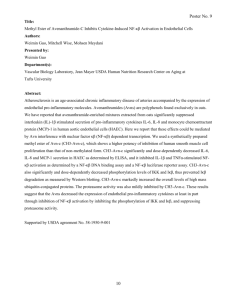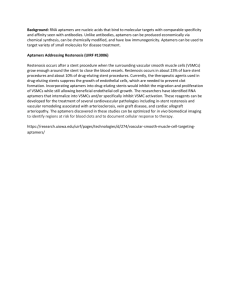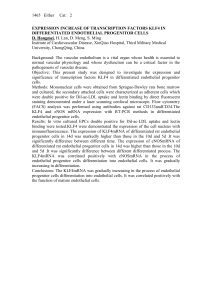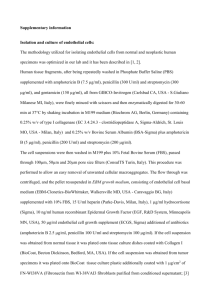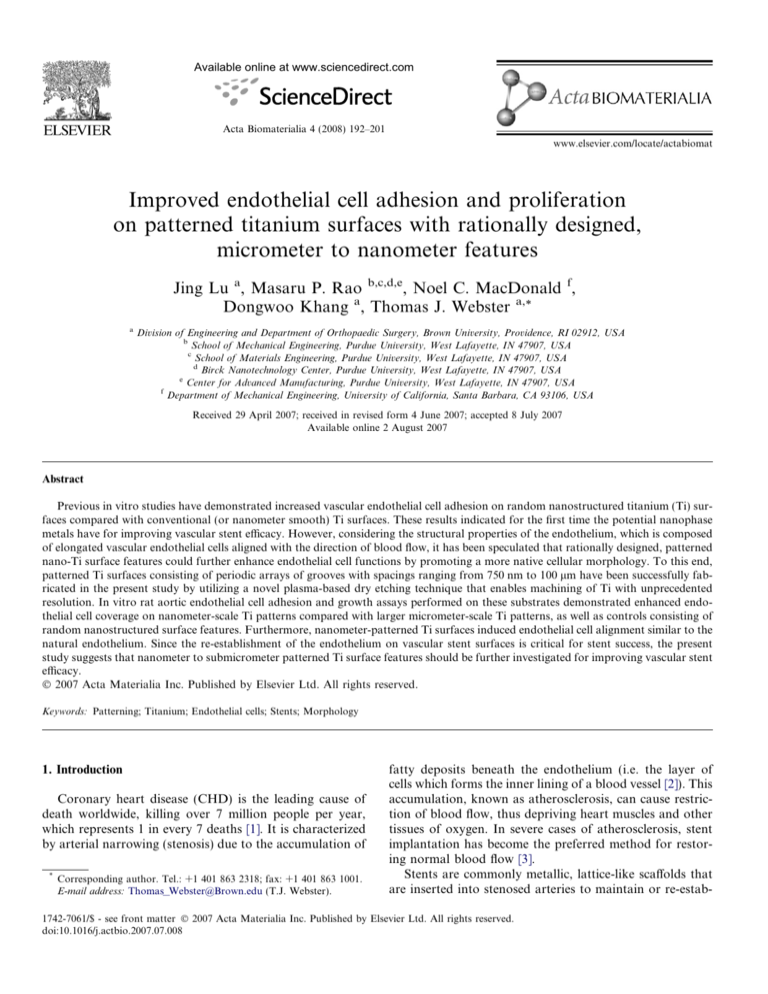
Available online at www.sciencedirect.com
Acta Biomaterialia 4 (2008) 192–201
www.elsevier.com/locate/actabiomat
Improved endothelial cell adhesion and proliferation
on patterned titanium surfaces with rationally designed,
micrometer to nanometer features
Jing Lu a, Masaru P. Rao b,c,d,e, Noel C. MacDonald f,
Dongwoo Khang a, Thomas J. Webster a,*
a
Division of Engineering and Department of Orthopaedic Surgery, Brown University, Providence, RI 02912, USA
b
School of Mechanical Engineering, Purdue University, West Lafayette, IN 47907, USA
c
School of Materials Engineering, Purdue University, West Lafayette, IN 47907, USA
d
Birck Nanotechnology Center, Purdue University, West Lafayette, IN 47907, USA
e
Center for Advanced Manufacturing, Purdue University, West Lafayette, IN 47907, USA
f
Department of Mechanical Engineering, University of California, Santa Barbara, CA 93106, USA
Received 29 April 2007; received in revised form 4 June 2007; accepted 8 July 2007
Available online 2 August 2007
Abstract
Previous in vitro studies have demonstrated increased vascular endothelial cell adhesion on random nanostructured titanium (Ti) surfaces compared with conventional (or nanometer smooth) Ti surfaces. These results indicated for the first time the potential nanophase
metals have for improving vascular stent efficacy. However, considering the structural properties of the endothelium, which is composed
of elongated vascular endothelial cells aligned with the direction of blood flow, it has been speculated that rationally designed, patterned
nano-Ti surface features could further enhance endothelial cell functions by promoting a more native cellular morphology. To this end,
patterned Ti surfaces consisting of periodic arrays of grooves with spacings ranging from 750 nm to 100 lm have been successfully fabricated in the present study by utilizing a novel plasma-based dry etching technique that enables machining of Ti with unprecedented
resolution. In vitro rat aortic endothelial cell adhesion and growth assays performed on these substrates demonstrated enhanced endothelial cell coverage on nanometer-scale Ti patterns compared with larger micrometer-scale Ti patterns, as well as controls consisting of
random nanostructured surface features. Furthermore, nanometer-patterned Ti surfaces induced endothelial cell alignment similar to the
natural endothelium. Since the re-establishment of the endothelium on vascular stent surfaces is critical for stent success, the present
study suggests that nanometer to submicrometer patterned Ti surface features should be further investigated for improving vascular stent
efficacy.
2007 Acta Materialia Inc. Published by Elsevier Ltd. All rights reserved.
Keywords: Patterning; Titanium; Endothelial cells; Stents; Morphology
1. Introduction
Coronary heart disease (CHD) is the leading cause of
death worldwide, killing over 7 million people per year,
which represents 1 in every 7 deaths [1]. It is characterized
by arterial narrowing (stenosis) due to the accumulation of
*
Corresponding author. Tel.: +1 401 863 2318; fax: +1 401 863 1001.
E-mail address: Thomas_Webster@Brown.edu (T.J. Webster).
fatty deposits beneath the endothelium (i.e. the layer of
cells which forms the inner lining of a blood vessel [2]). This
accumulation, known as atherosclerosis, can cause restriction of blood flow, thus depriving heart muscles and other
tissues of oxygen. In severe cases of atherosclerosis, stent
implantation has become the preferred method for restoring normal blood flow [3].
Stents are commonly metallic, lattice-like scaffolds that
are inserted into stenosed arteries to maintain or re-estab-
1742-7061/$ - see front matter 2007 Acta Materialia Inc. Published by Elsevier Ltd. All rights reserved.
doi:10.1016/j.actbio.2007.07.008
J. Lu et al. / Acta Biomaterialia 4 (2008) 192–201
lish vascular patency. In their first embodiment, they simply served as mechanical support systems to prevent vascular elastic recoil. However, they have since evolved to
incorporate biological functionality (such as impregnation
of pharmaceutical drugs) in order to mitigate neointimal
hyperplasia and decrease immune responses initiated by
the injury created through stent implantation. This detrimental immune response is characterized by excessive tissue in-growth into the lumen, which can cause renarrowing of arteries over time (restenosis) [4–6]. As
detailed in recent reviews [7–14], considerable effort has
been dedicated to addressing this issue. However, the most
successful solution to date has been the drug-eluting stent
(DES), which relies on the delivery of anti cell-proliferative
drugs from a polymer coating on the stent; such drugs inhibit cellular responses which lead to hyperplasia. In clinical
trials, DES has been shown to significantly reduce restenosis relative to bare-metal stents [15,16]. Consequently, DES
adoption has been rapid and widespread since FDA
approval in 2002.
However, despite the success of DES, recent studies
have begun to question the wisdom of a therapeutic strategy effectively based on the inhibition of healing. In particular, there is growing evidence that the incidence of stentrelated thrombosis (i.e. clotting) is higher in DES than
bare-metal stents, particularly after cessation of adjunctive
anti-platelet therapy. Moreover, the incidence of stentrelated thrombosis increases considerably when there is
premature discontinuation of such therapies [17–27]. While
overall incidences of stent-related thrombosis in DES is low
(<1.5%), these results provide significant cause for concern
because the fatalities in such cases can be as high as 45%
[22]. Although the mechanism of stent-related thrombosis
has yet to be fully understood, a causal relationship
between DES and delayed healing has been established.
Most significantly, drug-induced inhibition of hyperplasia
also inhibits the re-establishment of a healthy endothelium;
thus, such approaches increase the potential for thrombogenic stimuli [28,19,23]. This, therefore, provides the impetus for the exploration of alternative therapeutic strategies
that enhance, rather than inhibit, endothelialization of
metallic stent surfaces.
In this light, a number of studies have begun to show the
promise of healing-based strategies for increasing vascular
stent efficacy. All presume that rapid restoration of the
endothelium over the stent will enable its isolation from circulating blood, and therefore reduce the potential for restenosis and thrombosis. To date, most have focused on the
use of bioactive agents (such as growth factors, peptides,
and antibodies) which have been delivered locally via coating-based elutions, surface-immobilizations, or porous balloon catheters [28–35]. However, as in DES, the efficacy of
such approaches is often critically dependent upon spatial
and/or temporal control of bioactive agent delivery. Moreover, consideration must also be given to the potentially
detrimental consequences of unintended systemic delivery
[36,37]. Thus, the focus of this study was to develop tech-
193
niques that can increase endothelialization without the
use of bioactive agents.
One approach that seems promising in this context is the
creation of nanoscale features on vascular metallic stent
surfaces which mimic the natural structure of the healthy
vessel wall. Choudhary et al. recently showed greater vascular cell adhesion on metal surfaces with random nanostructured features [38]. It was demonstrated that metals
with random nanostructured surface features invoked vascular cell responses promising for improving stent efficacy
[38]. However, since native endothelial cells adopt an elongated, aligned morphology in the vasculature, it can be
argued that patterned surface features on metallic stents
may be better for increasing endothelial cell functions.
Thus, the objective of this in vitro study was to investigate
endothelial cell function on surfaces with rationally
designed patterns composed of periodic arrays of nanometer-wide grooves compared with both micrometer-wide
grooves and no grooves at all.
2. Materials and methods
2.1. Fabrication of patterned titanium substrates
Plasma dry etching-based micromachining techniques
were used to define uniform, high-precision patterns on
the surface of titanium substrates in the present study.
Wafer-based substrates composed of polished grade 1 Ti
(99.6% Ti, Tokyo Stainless Grinding Co., Ltd., Japan,
RA 10 nm RMS) were first cleaned in subsequent ultrasonic baths of acetone and isopropanol, followed by rinsing
with deionized (DI) water and drying with N2 gas. The
wafers were then dehydration baked on a hotplate at
150 C for 3 min. The wafers were primed with hexamethyldisilazane (an adhesion promoter) and a layer photoresist
(Shipley SPR 955) was applied by spin-coating. After lithographic exposure (GCA 6300 i-line wafer stepper), the
wafers were baked at 95 C for 60 s, then developed (Shipley
MF 701) for 60 s, rinsed in DI water and dried with N2 gas.
The lithographically defined patterns in the present
study were composed of nine 5 · 5 mm2 subregions, each
of which was composed of a periodic array of lines of equal
width and spacing ranging from 750 nm to 100 lm. A different line width was used for each subpattern, thus
enabling the definition of nine unique topographical
regions within the same die. The photoresist patterns were
transferred into the underlying substrate using the titanium
inductively coupled plasma deep etch (TIDE) process [39].
The TIDE process is based on anisotropic dry etching of Ti
in Cl2/Ar plasma. It provides, for the first time, the capability for machining Ti with unprecedented resolution in a
manner that is intrinsically scalable to low-cost/high-volume manufacturing, owing to its reliance on batch processing techniques derived from the microelectronics industry.
Following etching, the photoresist was stripped using ultrasonic agitation, first in acetone, then in isopropanol. The
samples were then rinsed in DI and dried with N2 gas.
194
J. Lu et al. / Acta Biomaterialia 4 (2008) 192–201
2.2. Fabrication of control materials
2.5. Endothelial cell adhesion and cell density assays
Three types of controls were used in the current study:
(i) smooth titanium; (ii) titanium with random nanostructured surface features; and (iii) glass coverslips.
The smooth Ti samples were unpatterned versions of
the polished substrates used for the patterned samples.
The random nanostructured control samples were thin
discs (12 mm diameter, 0.5 mm thickness) created by cold
compaction of 99.38% commercially pure Ti nanopowders (average particle size: 100 nm, Reade International
Inc.) according to standard techniques [40]. Briefly,
nanopowders were loaded into a hardened tool steel
die and compacted using a uniaxial, single-ended hydraulic press (Carver Inc.; compaction conditions: 10 GPa
pressure, 10 min at room temperature in an ambient
environment). The glass coverslip (Fisher) control samples were prepared by etching in a 1 N NaOH solution
for 1 h.
Before cell culture experiments, all substrates were
rinsed in acetone for 5 min, ethanol for 5 min and finally
DI water for another 5 min. They were then sterilized by
autoclaving (115–120 C) for 30 min.
For initial cell adhesion tests, RAEC were seeded at
4500 cells cm 2 in MCDB-131 Complete Medium onto
the substrates for 4 h under standard cell culture conditions. The samples were then rinsed with phosphate-buffered saline (PBS) three times to remove non-adherent
cells to prepare them for cell viability analysis.
For longer-term cell density assays, RAEC were seeded
at 2500 cells cm 2 in MCDB-131 Complete Medium onto
the substrates. Cells were cultured for 1, 3 and 5 days.
Medium was refreshed on days 2 and 4. At the end of days
1, 3 and 5, non-adherent cells on all the substrates were
removed by rinsing three times with PBS to prepare them
for cell viability analysis.
Cell viability was determined in situ by a LIVE/DEAD
Viability/Cytotoxicity Kit for mammalian cells (Molecular
Probes). Briefly, the cells were stained with 3.3 lM of calcein AM and 1.7 lM of ethidium homodimer-1 and incubated for 30 min before visualization using fluorescence
microscopy. The live and dead cells were counted using
530 nm wavelength excitation for calcein AM and 560 nm
for ethidium homodimer-1. Five random fields were
counted per substrate area of interest. Experiments were
conducted in triplicate and repeated at three different times.
Endothelial cell morphology on the substrates after the
5 day assay was also quantified using SEM. Briefly, after
the prescribed time period, endothelial cells were fixed with
formalin for 5 min. Afterwards, they were dehydrated by
soaking serially in 10%, 30%, 50%, 70% and 90% ethanol
for 30 min followed by soaking in 100% ethanol for
15 min three times. Lastly, the substrates were critical point
dried before visualization.
2.3. Substrate characterization
Scanning electron microscopy (SEM; LEO 1530 VP)
was used to characterize the surfaces of the patterned Ti
substrates. Prior to imaging, the substrates were sputtercoated with a thin layer of gold–palladium in a 100 mTorr
vacuum argon environment for 3 min using a current of
100 mA. SEM imaging was performed at 5 kV accelerating voltage. It should be noted that these sputter-coated
samples were not used for subsequent cell culture
experiments.
The surface topography of the patterned Ti substrates
was further characterized by atomic force microscopy
(AFM; DimensionTM 3100, Nanoscope IIIa). Commercially
available AFM tips (radius of tip curvature <10 nm,
NSC15/ALBS, MikroMasch) were used in tapping mode.
Tips with a full tip cone angle of <10 in the last 200 nm
of the tip apex were used (25 lm full tip height, 30 full
cone angle after initial 200 nm, 40 N m 1 force constant).
The scan rate was fixed at 0.5 Hz.
2.4. Endothelial cell culture
To test the endothelial cell responses on the patterned
Ti, rat aortic endothelial cells (RAEC) were purchased
from VEC Technologies. For culturing, Petri dishes were
coated with 0.2% gelatin (Sigma) by immersion in 0.2% gelatin for 2 h at room temperature, followed by air drying in
a laminar flow hood for 12 h. RAEC were then cultured in
MCDB-131 Complete Medium (VEC Technologies) under
standard cell culture conditions (37 C, humidified, 5%
CO2/95% air environment). Fresh medium was replenished
every other day.
3. Results
3.1. Patterned substrate topographical characterization
Scanning electron micrographs (Fig. 1) and AFM
images (Fig. 2) demonstrated the high-resolution patterning capability of the TIDE process. Periodic arrays of uniform grooves with nearly vertical sidewalls were created
with widths and spacings ranging from hundreds of nanometers (750 nm) to many tens of micrometers. The sporadic
thin bright lines and spots observed in the etched grooves
(darker stripes) of the SEM micrographs (Fig. 1) of the patterned samples are artifacts due to the dry etching process.
They were caused by the presence of impurities in the titanium substrate material that were not etched by the Cl2/Ar
plasma. Their incidence decreased considerably with
decreasing feature size and they were virtually non-existent
in the nanometer patterned samples.
3.2. Endothelial cell adhesion after 4 h on patterned Ti
Results from the 4 h endothelial cell adhesion tests indicated that endothelial cell density increased significantly as
J. Lu et al. / Acta Biomaterialia 4 (2008) 192–201
195
Fig. 1. Scanning electron microscope (SEM) images of Ti patterned surface features of: (A) 750 nm, bar = 1 lm; (B) 2 lm, bar = 1 lm; (C) 5 lm,
bar = 1 lm; (D) 25 lm, bar = 20 lm; (E) 75 lm, bar = 20 lm; and (F) 100 lm, bar = 20 lm; random nanostructured surface features of (G) bar = 10 lm
and (H) bar = 200 nm. The thin, non-uniform bright lines and spots observed in the etched grooves (darker stripes) are artifacts of the dry etching process.
the Ti pattern dimensions decreased to the nanometer scale
(Fig. 3). Moreover, when compared with the cell density on
the random nanostructured and smooth Ti surfaces, endothelial cell density was greater on the nanopatterned Ti surfaces. The cells also began to spread and align on the
nanopatterned Ti surfaces when the dimensions were less
than 10 lm (Fig. 4); this was not observed on larger micropatterned Ti samples, nor on the random nanostructured
Ti, smooth Ti or glass control surfaces.
3.3. Endothelial cell density after 1, 3 and 5 days on
patterned Ti
Longer-term cultures demonstrated similar trends as
observed for the 4 h cultures. Specifically, endothelial cell
density on the 750 nm patterned Ti surfaces was twice that
on the 100 lm patterned surfaces after 1 day (Fig. 5) and
cellular alignment increased considerably with decreasing
feature size (Fig. 6). After 3 days, endothelial cell density
continued to be greater on the Ti patterns with feature size
less than 10 lm (Fig. 7). Furthermore, cellular alignment
and elongation was far more pronounced for patterns with
features less than 10 lm.
Importantly, endothelial cells formed a confluent layer
on all patterned Ti substrates before completion of the 5
day culture experiments (Fig. 8). In contrast, confluence
was not achieved after 5 days for any of the control surfaces (i.e. smooth Ti, random nanostructured Ti, or glass).
Furthermore, confluence occurred most quickly on the Ti
surfaces with patterns less than 10 lm, with the 750 nm
patterns reaching confluence first. Finally, the affect of
decreasing pattern feature size on cellular alignment and
morphology is demonstrated in Fig. 9. The length/width
ratio of the endothelial cells on the 1 lm patterns is considerably greater than those on the 100 lm patterns.
4. Discussion
This in vitro study represents the first exploration of
endothelial cell adhesion, proliferation and morphology
on rationally designed patterned Ti surfaces composed
of periodic arrays of grooves with width and spacing
ranging from 750 nm to 100 lm. The data demonstrated
superior endothelial cell function and orientation on patterned Ti surfaces relative to all other surfaces investigated (i.e. smooth Ti, random nanostructured Ti and
glass). Moreover, the data demonstrated increasing benefits with decreasing pattern feature sizes, thus suggesting
that even greater promise may lie in further feature size
reduction. It should be noted, however, that these results
are not necessarily indicative of the potential for success
in vivo, due to the complexity of the in vivo environment.
As such, further studies are ongoing to assess the effects
of competitive adhesion with vascular smooth muscle cells
in vitro as well as the translation of these results to an
in vivo environment. Successful outcomes of these experiments will provide further evidence of the promise of this
approach.
196
J. Lu et al. / Acta Biomaterialia 4 (2008) 192–201
Fig. 2. Atomic force microscope (AFM) images of Ti patterned surface features of: (A) 750 nm, scan scale = 10 lm; (B) 1 lm, scan scale = 10 lm; (C)
2 lm, scan scale = 10 lm and (D) 5 lm, scan scale = 30 lm.
Importantly, this study introduces a new technique that
can produce, with high precision and reproducibility, nanometer to micrometer-scale surface features on Ti. When
coupled with high-resolution lithographic patterning, the
gentle, molecular-scale material removal mechanism of
the TIDE process enables machining at a far smaller scale
than is possible with conventional stent machining tech-
niques (such as laser micromachining (LMM), photoetching and microelectrodischarge machining (lEDM), all
of which are limited to minimum feature sizes in excess
of tens of micrometers in practice [41,42]). However,
plasma etching also compares favorably to these
techniques on the micro/mesoscale. TIDE is a parallel,
batch-scale process, thus making it inherently scalable to
J. Lu et al. / Acta Biomaterialia 4 (2008) 192–201
197
Fig. 3. Increased rat aortic endothelial cell (RAEC) adhesion after four hour culture on nano to sub-micrometer patterns compared to micrometer-scale
patterns and random nanostructured Ti features. Data = mean ± SEM; N = 6; *,**p < 0.01 (compared to Ti patterns of 100 lm and random
nanostructured Ti, respectively).
Fig. 4. Rat aortic endothelial cell (RAEC) cell density after four hours of culture on Ti patterns of (A) 750 nm; (B) 2 lm; (C) 5 lm; (D) 75 lm; (E) 100 lm
and (F) random nanostructured Ti surfaces. (A–F) bars = 50 lm. Arrows indicate groove alignment direction on patterned samples.
low-cost/high-volume manufacturing, unlike LMM and
lEDM, which are slower, serial processes. Furthermore,
in addition to providing higher-resolution machining
capability, lithographic patterning also enables better
tolerances and reproducibility than what is possible with
conventional techniques, thus ensuring greater quality control and reliability. Finally, the gentle machining mechanism
of plasma etching produces little or no debris or damage,
thus minimizing the need for common post-machining processes, such as electropolishing. As such, the TIDE process
is the only technique currently available that has the potential to produce nanometer to micrometer-scale patterning in
stents in a reliable and cost-effective manner.
Clearly, it is important to consider the mechanism of
why endothelial cell responses were improved on these nanopatterned Ti surfaces. Although not directly addressed
here, other studies have attributed improved cellular
responses on nano- to submicron-scale patterned surfaces
to a physical effect; that is, changes in the alignment and
shape of cells (as controlled by the underlying surface features) have been related to improved cell functions [43].
For example, Palmaz et al. have reported higher endothelial cell migration rates on Nitinol surfaces consisting of
micrometer-scale grooves compared with smooth metal
surfaces [44]. They hypothesized that such patterns may
reduce time to endothelialization of vascular stents, thus
198
J. Lu et al. / Acta Biomaterialia 4 (2008) 192–201
Fig. 5. Increased rat aortic endothelial cell (RAEC) cell density after the first day of culture on patterned Ti surface features. Data = mean ± SEM; N = 3;
*p < 0.05 (compared to the patterns of 100 and 75 lm) and **p < 0.05 (compared to random nanostructured surface features).
Fig. 6. Rat aortic endothelial cell (RAEC) cell density after the first day of culture on Ti patterns of: (A) 750 nm; (B) 2 lm; (C) 5 lm; (D) 75 lm; (E)
100 lm and (F) random nanostructured Ti surfaces. (A–F) bars = 50 lm. Arrows indicate groove alignment direction on patterned samples.
reducing the risk of in-stent restenosis and late-stage
thrombosis [44]. They attributed this increase to a physical
effect; that is, changes in the alignment and shape of cells
were related to a simple cell conformation process on the
microgrooves. Other studies have confirmed that cell shape
and orientation are related to cell gene expression [45].
Changes in cell shape may thus affect much of the metabolism of a cell.
However, there is some contradiction in the literature
concerning the influence of surface patterns on cell alignment. While there has been only limited exploration of this
for nano- to submicrometer-scale surface features [46], this
has been extensively studied for materials with micrometer-
scale or greater surface features. Some studies have indicated that the degree of cell alignment increases with
groove size [48], while others show that the higher the concentration of ridges on the grooved surface, the greater the
effect on cell morphology [47]. Consequently, it is apparent
that the influence of the dimensions of surface patterning is
another important subject to be studied further in which
unique enhancements may be made when going down to
the nanoscale, as this study suggests.
The data presented here clearly indicate a strong
enhancement of endothelial cell function with decreasing
pattern feature sizes into the nanometer regime. As such,
within the context of the application towards improving
J. Lu et al. / Acta Biomaterialia 4 (2008) 192–201
199
Fig. 7. Rat aortic endothelial cell (RAEC) cell density after the third day of culture on Ti patterns of (A) 750 nm; (B) 1 lm; (C) 5 lm; (D) 75 lm; (E)
100 lm and (F) random nanostructured Ti surfaces. (A–F) bars = 50 lm. Arrows indicate groove alignment direction on patterned samples.
Fig. 8. Rat aortic endothelial cell (RAEC) proliferation after the fifth day of culture on Ti patterns of: (A) 750 nm; (B) 2 lm; (C) 5 lm; (D) 75 lm; (E)
100 lm and (F) random nanostructured Ti surfaces. (A–F): bars = 50 lm. Arrows indicate groove alignment direction on patterned samples.
vascular stents, this approach may offer a unique opportunity. The inherent precision and uniformity of the fabrication method used to create the patterned surfaces may
enable better control and reproducibility of cellular
responses than uncontrolled surfaces whose spatial uniformity may vary widely. Moreover, patterning of the surface
of the stent material itself may enable incorporation of
multi-functionality based solely on the rational design of
stent structures at varying length scales. More specifically,
micro- and mesoscale stent features would define the
mechanical response of the stent, while nano- to submicrometer-scale topographical features would define its
biological response. No other materials or agents would
be needed (such as the aforementioned pharmaceutical
agents which inhibit a healing response). If successful, a
monolithic integration approach (such as this) has the
potential to be inherently more reliable than current
multi-component approaches employing pharmaceutical
agents.
Finally, although beyond the scope of the current study,
it is anticipated that patterning at the nanometer and
micrometer scale via the TIDE process will find similar utility in other implantation applications as well. For example,
cues provided by nanopatterned surface features could
200
J. Lu et al. / Acta Biomaterialia 4 (2008) 192–201
Fig. 9. SEM images of rat aortic endothelial cell (RAEC) morphology after the fifth day of culture on Ti patterns of: (A) 1 lm; (B) 100 lm. Bars = 20 lm.
facilitate the orientation of deposited calcium containing
minerals and collagen by bone-forming cells, thus improving integration of orthopaedic implants. Indeed, evidence
of this has already been demonstrated at the micrometer
scale, where the formation of bone-like cell multilayers
was observed to occur more quickly on microgrooved surfaces (150 lm) than smooth surfaces [48]. However, the
effect of nanopatterned surfaces (as the TIDE process
could provide) has yet to be investigated.
5. Conclusions
In summary, rationally designed patterned Ti surfaces
with features ranging from 750 nm to 100 lm have been
created using a novel micromachining process which provided the capability for creating surface features with
unparalleled control and resolution. These nanofeatures
have been shown to promote endothelial cell function on
Ti to mimic that of the native endothelium. Such results
therefore suggest that nanopatterned Ti substrates should
be further studied as a means of improving vascular stent
efficacy.
Acknowledgements
The authors gratefully thank the Coulter Foundation
for funding, and Dr. Robbert Créton and Mr. Geoffrey
Williams for help with fluorescence microscopy.
References
[1] Mackay J, Mensah G, editorsThe atlas of heart disease and
stroke. Geneva: World Health Organization; 2004.
[2] Libby P, Ridker PM, Maseri A. Inflammation and atherosclerosis.
Circulation 2002;105(9):1135–43.
[3] Thom T, Haase N, Rosamond W, Howard VJ, Rumsfeld J, Manolio
T, et al. Heart disease and stroke statistics – 2006 update: a report
from the American Heart Association statistics committee and stroke
subcommittee. Circulation 2006;113(6):E 85–151.
[4] Hoffmann R, Mintz GS, Dussaillant GR, Popma JJ, Pichard AD,
Satler LF, et al. Patterns and mechanisms of in-stent restenosis – a
serial intravascular ultrasound study. Circulation 1996;94(6):1247–54.
[5] Farb A, Sangiorgi G, Carter AJ, Walley VM, Edwards WD, Schwartz
RS, et al. Pathology of acute and chronic coronary stenting in
humans. Circulation 1999;99(1):44–52.
[6] Schwartz RS, Chronos NA, Virmani R. Preclinical restenosis models
and drug-eluting stents: still important, still much to learn. J Am Coll
Cardiol 2004;44(7):1373–85.
[7] Palmaz JC. New advances in endovascular technology. Texas Heart
Inst J 1997;24(3):156–9.
[8] Topol EJ. Coronary-artery stents: gauging, gorging, and gouging
[editorial]. N Engl J Med 1998;339(23):1702–4.
[9] Schömig A, Kastrati A. Long lesions, long stents and the long process
of stent optimization [editorial]. J Am Coll Cardio 1999;34(3):660–2.
[10] Kastrati A, Hall D, Schömig A. Long-term outcome after coronary
stenting [review]. Curr Control Trials Cardiovasc Med 2000;1(1):
48–54.
[11] Palmaz JC, Bailey S, Marton D, Sprague E. Influence of stent design
and material composition on procedural outcome. J Vasc Surg
2002;36(5):1031–9.
[12] Palmaz JC. Intravascular stents in the last and the next 10 years. J
Endovasc Ther 2004;11(suppl. 2):200–6.
[13] Hara H, Nakamura M, Palmaz JC, Schwartz RS. Role of stent design
and coatings on restenosis and thrombosis. Adv Drug Deliver Rev
2006;58(3):377–86.
[14] Whittaker DR, Fillinger MF. The engineering of endovascular stent
technology: a review. Vasc Endovasc Surg 2006;40(2):85–94.
[15] Moses JW, Leon MB, Popma JJ, Fitzgerald PJ, Holmes DR,
O’Shaughnessy C, et al. Sirolimus-eluting stents versus standard
stents in patients with stenosis in a native coronary artery. N Engl J
Med 2003;349(14):1315–23.
[16] Stone GW, Ellis SG, Cox DA, Hermiller J, O’Shaughnessy C, Mann
JT, et al. A polymer-based, paclitaxel-eluting stent in patients with
coronary-artery disease. N Engl J Med 2004;350(3):221–31.
[17] McFadden EP, Stabile E, Regar E, Cheneau E, Ong ATL, Kinnaird
T, et al. Late thrombosis in drug-eluting coronary stents after
discontinuation of antiplatelet therapy. Lancet 2004;364(9444):
1519–21.
[18] Virmani R, Guagliumi G, Farb A, Musumeci G, Greico N, Motta T,
et al. Localized hypersensitivity and late coronary thrombosis
secondary to a sirolimus-eluting stent: should we be cautious?
Circulation 2004;109(6):701–5.
[19] Joner M, Finn AV, Farb A, Mont EK, Kolodgie FD, Ladisch E,
et al. Pathology of drug-eluting stents in humans: delayed healing
and late thrombotic risk. J Am Coll Cardiol 2005;48(1):193–202.
[20] Ong ATL, McFadden EP, Regar E, de Jaegere PPT, van Domburg
RT, Serruys PW. Late angiographic stent thrombosis (LAST) events
with drug-eluting stents. J Am Coll Cardiol 2005;45(12):2088–92.
[21] Ong ATL, Serruys PW. Drug-eluting stents: current issues [key note
address]. Texas Heart Inst J 2005;32(3):372–7.
J. Lu et al. / Acta Biomaterialia 4 (2008) 192–201
[22] Iakovou I, Schmidt T, Bonizzoni E, Ge L, Sangiorgio GM, Stankovic
G, et al. Incidence, predictors, and outcome of thrombosis after
successful implantation of drug-eluting stents. JAMA 2005;293(17):
2126–30.
[23] Nebeker JR, Virmani R, Bennett CL, Hoffman JM, Samore MH,
Alvarez J, et al. Hypersensitivity cases associated with drug-eluting
coronary stents: a review of available cases from the research on
adverse drug events and reports (RADAR) project. J Am Coll
Cardiol 2006;47(1):175–81.
[24] Kuchulakanti PK, Chu WW, Torguson R, Ohlmann P, Rha SW,
Clavijo LC, et al. Correlates and long-term outcomes of angiographically proven stent thrombosis with sirolimus- and paclitaxel-eluting
stents. Circulation 2006;113(8):1108–13.
[25] Spertus JA, Kettelkamp R, Vance C, Decker C, Jones PG, Rumsfeld
JS, et al. Prevalence, predictors, and outcomes of premature discontinuation of thienopyridine, therapy after drug-eluting stent placement: results from the PREMIER registry. Circulation 2006;113(24):
2803–9.
[26] Do drug-eluting stents increase deaths? Retrieved September 11, 2006
from European Society of Cardiology, ESC Event News, 2006 World
Congress of Cardiology. <http://www.escardio.org/vpo/News/
events/wcc_drugelutingstents_events.htm>.
[27] Boston scientific confirms long-term clotting risk of drug-eluting
stents. Retrieved September 11, 2006 from Angioplasty.org website.
<http://www.ptca.org/news/2006/0907.html>.
[28] Shirota T, Yasui H, Shimokawa H, Matsuda T. Fabrication of
endothelial progenitor cell (EPC)-seeded intravascular stent devices
and in vitro endothelialization on hybrid vascular tissue. Biomaterials
2003;24(13):2295–302.
[29] Walter DH, Cejna M, Diaz-Sandoval L, Willis S, Kirkwood L,
Stratford PW, et al. Local gene transfer of phVEGF-2 plasmid by
gene-eluting stents. Circulation 2004;110(1):36–45.
[30] Aoki J, Serruys PW, Van Beusekom H, Ong ATL, McFadden EP,
Sianos G, et al. Endothelial progenitor cell capture by stents coated
with antibody against CD34 – the HEALING-FIM (healthy endothelial accelerated lining inhibits neointimal growth – first in man)
registry. J Am Coll Cardiol 2005;45(10):1574–9.
[31] Tanquay JF. Vascular healing after stenting: the role of 17-betaestradiol in improving re-endothelialization and reducing restenosis.
Can J Cardiol 2005;21(12):1025–30.
[32] Anis RR, Karch KR. The future of drug eluting stents. Heart
2005;92(5):585–8.
[33] Cho HJ, Kim TY, Cho HJ, Park KW, Zhang SY, Kim JH, et al. The
effect of stem cell mobilization by granulocyte-colony stimulating
factor on neointimal hyperplasia and endothelial healing after
vascular injury with bare-metal versus paclitaxel-eluting stents. J
Am Coll Cardiol 2006;48(2):366–74.
201
[34] Pelisek J, Fuchs AT, Kuehnl A, Tian W, Kuhlmann MT, Choukri M,
et al. C-type natriuretic peptide for reduction of restenosis: gene
transfer is superior over single peptide administration. J Gene Med
2006;8(7):835–44.
[35] Patel HJ, Su S-H, Patterson C, Nguyen KT. A combined strategy to
reduce restenosis for vascular tissue engineering applications. Biotechnol Prog 2006;22(1):38–44.
[36] March KL, Trapnell BC. Pharmacokinetics of local viral vector
delivery to vascular tissues: Implications for efficiency and localization of transduction. In: March K L, editor. Gene transfer in the
cardiovascular system: experimental approaches and therapeutic
implications. Dordrecht: Kluwer; 1997. p. 483.
[37] March KL, Gradus-Pizlo I, Wilensky RL, Yei S, Trapnell BC.
Cardiovascular gene therapy using adenoviral vectors: distant transduction following local delivery using a porous balloon catheter. J
Am Coll Cardiol 1994;23(1):177A.
[38] Choudhary S, Berhe M, Haberstroh KM, Webster TJ. Increased
endothelial and vascular smooth muscle cell adhesion on nanostructured Ti and CoCrMo. Int J Nanomed 2006;1(1):41–9.
[39] Parker ER, Thibeault BJ, Aimi MF, Rao MP, MacDonald NC.
Inductively coupled plasma etching of bulk Ti for MEMS applications. J Electrochem Soc 2005;152(10):675–83.
[40] Webster TJ, Ejiofor JU. Increased osteoblast adhesion on nanophase
metals: Ti, Ti6Al4V, CoCrMo. Biomaterials 2004;25(19):4731–9.
[41] Kathuria YP. Laser microprocessing of metallic stent for medical
therapy. J Mater Process Tech 2005;170(3):545–50.
[42] Takahata K, Gianchandani YB. A planar approach for manufacturing cardiac stents: design, fabrication, and mechanical evaluation. J
Microelectromech S 2004;13(6):933–9.
[43] Ingber DE, Madri JA, Folkman J. Endothelial growth factors
and extracellular matrix regulate DNA synthesis through modulation
of cell and nuclear expansion. In Vitro Cell Dev Biol 1987;23(5):
387–94.
[44] Palmaz JC, Benson A, Eugene A. Influence of surface topography on
endothelialization of intravascular metallic material. J Vasc Interv
Radiol 1999;10(4):439–44.
[45] Ben-Ze’ev A. Animal cell shape changes and gene expression.
Bioassays 1991;13(5):201–12.
[46] Bettinger CJ, Orrick B, Misra A, Langer R, Borenstein JT. Micro
fabrication of poly (glycerol-sebacate) for contact guidance applications. Biomaterials 2006;27(12):2558–65.
[47] Khakbaznejad A, Chehroudi B, Brunette DM. Effects of titaniumcoated micromachined grooved substrata on orienting layers of
osteoblast-like cells and collagen fibers in culture. J Biomed Mater
Res 2004;70(2):206–18.
[48] Clark P, Connolly P, Curtis ASG, Dow JAT, Wilkinson CDW. Cell
guidance by ultrafine topography in vitro. J Cell Sci 1991;99:73–7.

